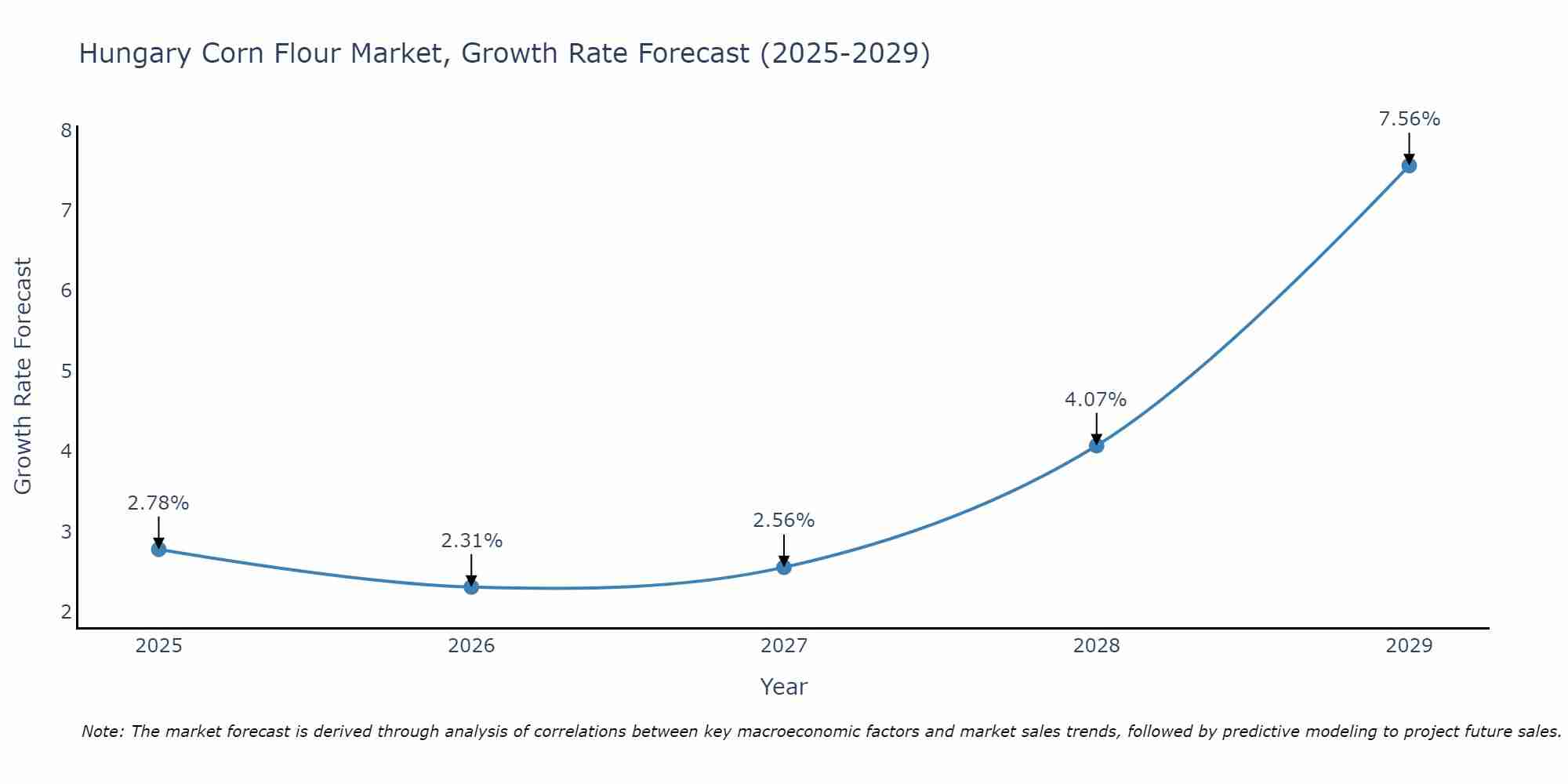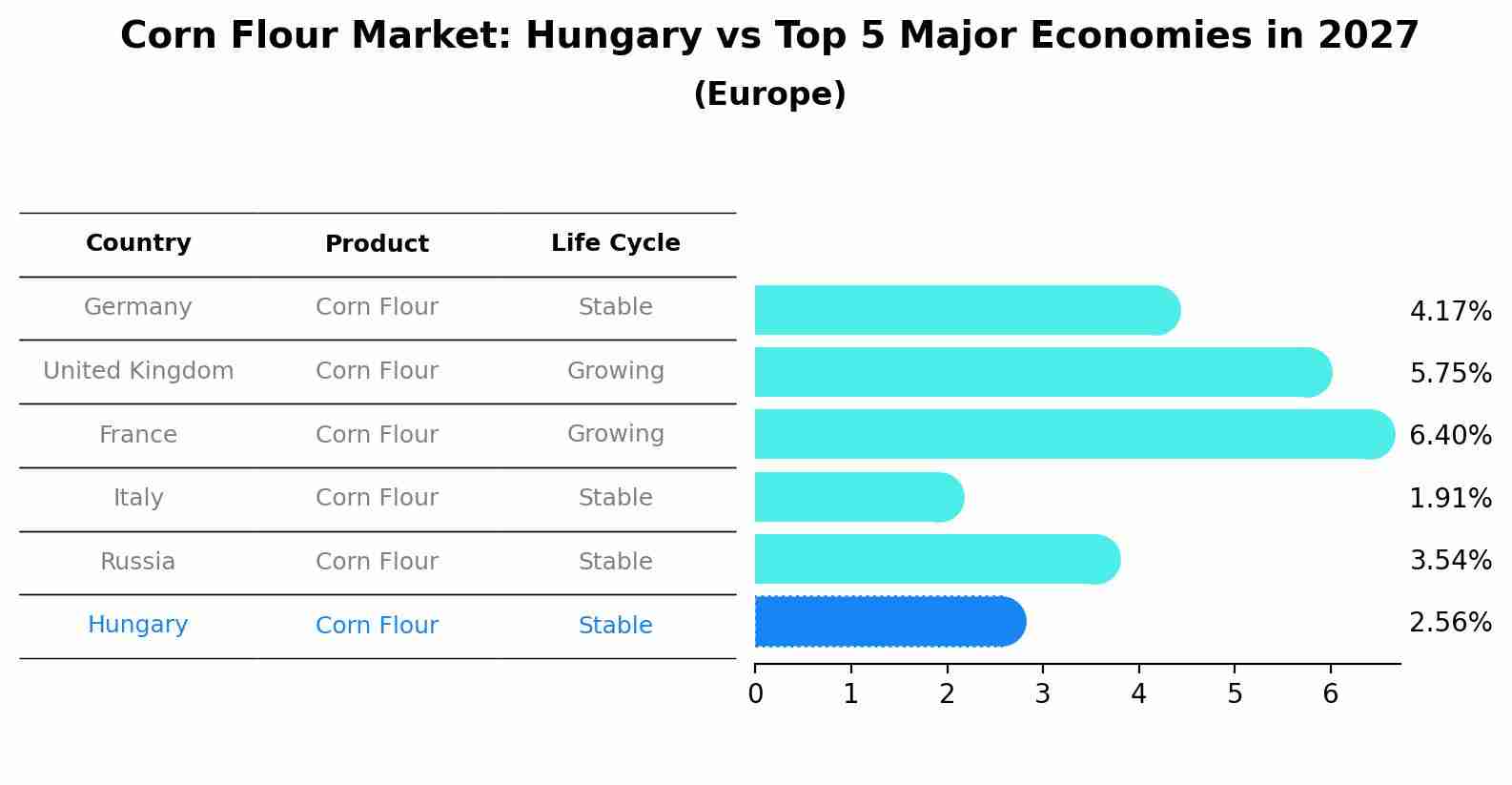Hungary Corn Flour Market | Analysis, Trends, Industry, Share, Size, Value, Growth, Companies, COVID-19 IMPACT, Revenue & Forecast
| Product Code: ETC178958 | Publication Date: Jan 2022 | Updated Date: Aug 2025 | Product Type: Market Research Report | |
| Publisher: 6Wresearch | Author: Ravi Bhandari | No. of Pages: 70 | No. of Figures: 35 | No. of Tables: 5 |
Hungary Corn Flour Market Size Growth Rate
The Hungary Corn Flour Market is projected to witness mixed growth rate patterns during 2025 to 2029. From 2.78% in 2025, the growth rate steadily ascends to 7.56% in 2029.

Corn Flour Market: Hungary vs Top 5 Major Economies in 2027 (Europe)
By 2027, the Corn Flour market in Hungary is anticipated to reach a growth rate of 2.56%, as part of an increasingly competitive Europe region, where Germany remains at the forefront, supported by United Kingdom, France, Italy and Russia, driving innovations and market adoption across sectors.

Hungary Corn Flour Market Overview
The Hungary Corn Flour market is influenced by factors such as changing dietary preferences, the popularity of gluten-free products, and the growing demand for convenience foods. Corn flour is used in various culinary applications such as baking, thickening sauces, and making tortillas and noodles. Market players focus on product innovation, branding, and distribution channels to cater to evolving consumer preferences and dietary trends.
Drivers of the market
The Hungary Corn Flour market is primarily driven by the growing demand for gluten-free alternatives and the increasing popularity of ethnic cuisines. Corn flour is widely used as a gluten-free substitute for wheat flour in various food applications, including baking, thickening sauces, and coating fried foods. As consumers become more health-conscious and seek alternatives to traditional wheat-based products, the demand for corn flour rises accordingly. Additionally, the influence of multiculturalism and the adoption of Mexican, Tex-Mex, and other international cuisines contribute to the market`s growth, as corn flour is a staple ingredient in dishes like tortillas, tamales, and cornbread.
Challenges of the market
Challenges in the Hungary corn flour market might include fluctuations in corn prices due to weather conditions and agricultural policies. Additionally, competition from wheat flour and gluten-free alternatives could pose challenges to market growth and profitability.
Government Policy of the market
The Hungary government regulates the corn flour market to uphold food safety standards and ensure fair competition among manufacturers. Policies include quality control measures to monitor the production process and enforce labeling requirements to provide consumers with accurate information. Additionally, there are initiatives to support domestic corn cultivation and processing industries, contributing to agricultural sustainability and economic growth.
Key Highlights of the Report:
- Hungary Corn Flour Market Outlook
- Market Size of Hungary Corn Flour Market, 2021
- Forecast of Hungary Corn Flour Market, 2028
- Historical Data and Forecast of Hungary Corn Flour Revenues & Volume for the Period 2018 - 2028
- Hungary Corn Flour Market Trend Evolution
- Hungary Corn Flour Market Drivers and Challenges
- Hungary Corn Flour Price Trends
- Hungary Corn Flour Porter's Five Forces
- Hungary Corn Flour Industry Life Cycle
- Historical Data and Forecast of Hungary Corn Flour Market Revenues & Volume By Application for the Period 2018 - 2028
- Historical Data and Forecast of Hungary Corn Flour Market Revenues & Volume By Bakery And Confectionary for the Period 2018 - 2028
- Historical Data and Forecast of Hungary Corn Flour Market Revenues & Volume By Snack Food for the Period 2018 - 2028
- Historical Data and Forecast of Hungary Corn Flour Market Revenues & Volume By Others for the Period 2018 - 2028
- Historical Data and Forecast of Hungary Corn Flour Market Revenues & Volume By Distribution Channel for the Period 2018 - 2028
- Historical Data and Forecast of Hungary Corn Flour Market Revenues & Volume By Online Retail for the Period 2018 - 2028
- Historical Data and Forecast of Hungary Corn Flour Market Revenues & Volume By Supermarkets/Hypermarkets for the Period 2018 - 2028
- Historical Data and Forecast of Hungary Corn Flour Market Revenues & Volume By Convenience Stores for the Period 2018 - 2028
- Historical Data and Forecast of Hungary Corn Flour Market Revenues & Volume By Others for the Period 2018 - 2028
- Hungary Corn Flour Import Export Trade Statistics
- Market Opportunity Assessment By Application
- Market Opportunity Assessment By Distribution Channel
- Hungary Corn Flour Top Companies Market Share
- Hungary Corn Flour Competitive Benchmarking By Technical and Operational Parameters
- Hungary Corn Flour Company Profiles
- Hungary Corn Flour Key Strategic Recommendations
Frequently Asked Questions About the Market Study (FAQs):
1 Executive Summary |
2 Introduction |
2.1 Key Highlights of the Report |
2.2 Report Description |
2.3 Market Scope & Segmentation |
2.4 Research Methodology |
2.5 Assumptions |
3 Hungary Corn Flour Market Overview |
3.1 Hungary Country Macro Economic Indicators |
3.2 Hungary Corn Flour Market Revenues & Volume, 2021 & 2028F |
3.3 Hungary Corn Flour Market - Industry Life Cycle |
3.4 Hungary Corn Flour Market - Porter's Five Forces |
3.5 Hungary Corn Flour Market Revenues & Volume Share, By Application, 2021 & 2028F |
3.6 Hungary Corn Flour Market Revenues & Volume Share, By Distribution Channel, 2021 & 2028F |
4 Hungary Corn Flour Market Dynamics |
4.1 Impact Analysis |
4.2 Market Drivers |
4.2.1 Increasing consumer awareness about the health benefits of corn flour |
4.2.2 Growing demand for gluten-free products |
4.2.3 Rise in the use of corn flour in various culinary applications |
4.3 Market Restraints |
4.3.1 Fluctuations in corn prices affecting production costs |
4.3.2 Competition from other alternative flours in the market |
4.3.3 Challenges in distribution and shelf-space availability |
5 Hungary Corn Flour Market Trends |
6 Hungary Corn Flour Market, By Types |
6.1 Hungary Corn Flour Market, By Application |
6.1.1 Overview and Analysis |
6.1.2 Hungary Corn Flour Market Revenues & Volume, By Application, 2018 - 2028F |
6.1.3 Hungary Corn Flour Market Revenues & Volume, By Bakery And Confectionary, 2018 - 2028F |
6.1.4 Hungary Corn Flour Market Revenues & Volume, By Snack Food, 2018 - 2028F |
6.1.5 Hungary Corn Flour Market Revenues & Volume, By Others, 2018 - 2028F |
6.2 Hungary Corn Flour Market, By Distribution Channel |
6.2.1 Overview and Analysis |
6.2.2 Hungary Corn Flour Market Revenues & Volume, By Online Retail, 2018 - 2028F |
6.2.3 Hungary Corn Flour Market Revenues & Volume, By Supermarkets/Hypermarkets, 2018 - 2028F |
6.2.4 Hungary Corn Flour Market Revenues & Volume, By Convenience Stores, 2018 - 2028F |
6.2.5 Hungary Corn Flour Market Revenues & Volume, By Others, 2018 - 2028F |
7 Hungary Corn Flour Market Import-Export Trade Statistics |
7.1 Hungary Corn Flour Market Export to Major Countries |
7.2 Hungary Corn Flour Market Imports from Major Countries |
8 Hungary Corn Flour Market Key Performance Indicators |
8.1 Consumer demand for corn flour-based products |
8.2 Adoption rate of corn flour by food manufacturers |
8.3 Number of new product launches containing corn flour in the market |
9 Hungary Corn Flour Market - Opportunity Assessment |
9.1 Hungary Corn Flour Market Opportunity Assessment, By Application, 2021 & 2028F |
9.2 Hungary Corn Flour Market Opportunity Assessment, By Distribution Channel, 2021 & 2028F |
10 Hungary Corn Flour Market - Competitive Landscape |
10.1 Hungary Corn Flour Market Revenue Share, By Companies, 2021 |
10.2 Hungary Corn Flour Market Competitive Benchmarking, By Operating and Technical Parameters |
11 Company Profiles |
12 Recommendations |
13 Disclaimer |
- Single User License$ 1,995
- Department License$ 2,400
- Site License$ 3,120
- Global License$ 3,795
Search
Related Reports
- Vietnam System Integrator Market (2025-2031) | Size, Companies, Analysis, Industry, Value, Forecast, Growth, Trends, Revenue & Share
- ASEAN and Thailand Brain Health Supplements Market (2025-2031) | Strategy, Consumer Insights, Analysis, Investment Trends, Opportunities, Growth, Size, Share, Industry, Revenue, Segments, Value, Segmentation, Supply, Forecast, Restraints, Outlook, Competition, Drivers, Trends, Demand, Pricing Analysis, Competitive, Strategic Insights, Companies, Challenges
- ASEAN Bearings Market (2025-2031) | Strategy, Consumer Insights, Analysis, Investment Trends, Opportunities, Growth, Size, Share, Industry, Revenue, Segments, Value, Segmentation, Supply, Forecast, Restraints, Outlook, Competition, Drivers, Trends, Demand, Pricing Analysis, Competitive, Strategic Insights, Companies, Challenges
- Europe Flooring Market (2025-2031) | Outlook, Share, Industry, Trends, Forecast, Companies, Revenue, Size, Analysis, Growth & Value
- Saudi Arabia Manlift Market (2025-2031) | Outlook, Size, Growth, Trends, Companies, Industry, Revenue, Value, Share, Forecast & Analysis
- Uganda Excavator, Crane, and Wheel Loaders Market (2025-2031) | Strategy, Consumer Insights, Analysis, Investment Trends, Opportunities, Growth, Size, Share, Industry, Revenue, Segments, Value, Segmentation, Supply, Forecast, Restraints, Outlook, Competition, Drivers, Trends, Demand, Pricing Analysis, Competitive, Strategic Insights, Companies, Challenges
- Rwanda Excavator, Crane, and Wheel Loaders Market (2025-2031) | Strategy, Consumer Insights, Analysis, Investment Trends, Opportunities, Growth, Size, Share, Industry, Revenue, Segments, Value, Segmentation, Supply, Forecast, Restraints, Outlook, Competition, Drivers, Trends, Demand, Pricing Analysis, Competitive, Strategic Insights, Companies, Challenges
- Kenya Excavator, Crane, and Wheel Loaders Market (2025-2031) | Strategy, Consumer Insights, Analysis, Investment Trends, Opportunities, Growth, Size, Share, Industry, Revenue, Segments, Value, Segmentation, Supply, Forecast, Restraints, Outlook, Competition, Drivers, Trends, Demand, Pricing Analysis, Competitive, Strategic Insights, Companies, Challenges
- Angola Excavator, Crane, and Wheel Loaders Market (2025-2031) | Strategy, Consumer Insights, Analysis, Investment Trends, Opportunities, Growth, Size, Share, Industry, Revenue, Segments, Value, Segmentation, Supply, Forecast, Restraints, Outlook, Competition, Drivers, Trends, Demand, Pricing Analysis, Competitive, Strategic Insights, Companies, Challenges
- Israel Intelligent Transport System Market (2025-2031) | Strategy, Consumer Insights, Analysis, Investment Trends, Opportunities, Growth, Size, Share, Industry, Revenue, Segments, Value, Segmentation, Supply, Forecast, Restraints, Outlook, Competition, Drivers, Trends, Demand, Pricing Analysis, Competitive, Strategic Insights, Companies, Challenges
Industry Events and Analyst Meet
Our Clients
Whitepaper
- Middle East & Africa Commercial Security Market Click here to view more.
- Middle East & Africa Fire Safety Systems & Equipment Market Click here to view more.
- GCC Drone Market Click here to view more.
- Middle East Lighting Fixture Market Click here to view more.
- GCC Physical & Perimeter Security Market Click here to view more.
6WResearch In News
- Doha a strategic location for EV manufacturing hub: IPA Qatar
- Demand for luxury TVs surging in the GCC, says Samsung
- Empowering Growth: The Thriving Journey of Bangladesh’s Cable Industry
- Demand for luxury TVs surging in the GCC, says Samsung
- Video call with a traditional healer? Once unthinkable, it’s now common in South Africa
- Intelligent Buildings To Smooth GCC’s Path To Net Zero













